Medical Image Processing Application: Acne Detection and Analysis
VerifiedAdded on 2023/04/03
|20
|3990
|298
Report
AI Summary
This paper proposes an application that uses image processing to detect acne on facial images, aiding doctors in diagnosis and treatment recommendations. The application employs methods like color segmentation, blob detection, and face detection, utilizing mathematical and statistical algorithms. It aims to reduce the need for face-to-face interaction between doctors and patients by analyzing facial images and highlighting acne-affected areas. The application draws inspiration from existing mobile applications that enhance images but focuses on identifying medical skin conditions. This technology promises to improve the efficiency and accessibility of acne diagnosis and treatment.
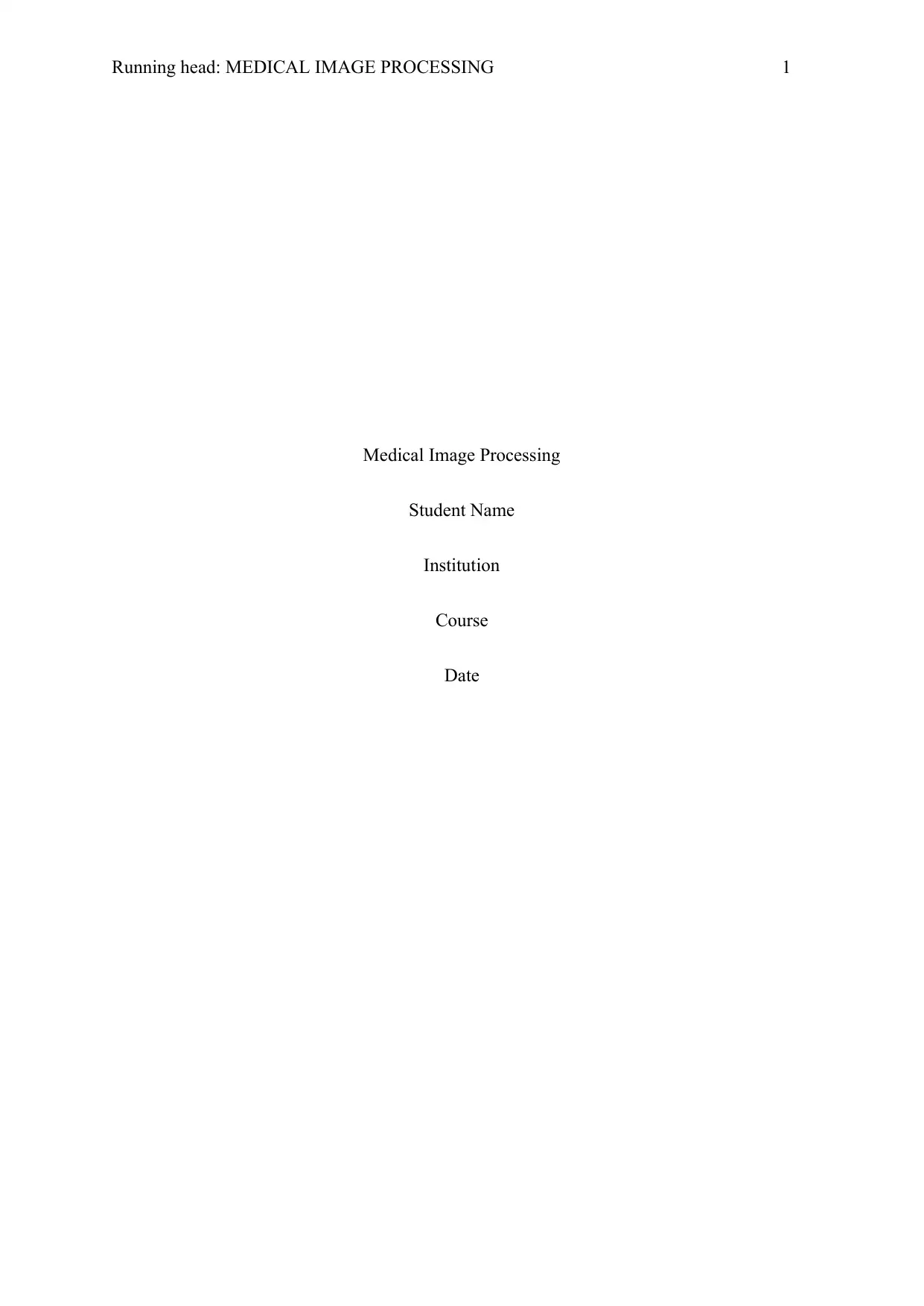
Running head: MEDICAL IMAGE PROCESSING 1
Medical Image Processing
Student Name
Institution
Course
Date
Medical Image Processing
Student Name
Institution
Course
Date
Paraphrase This Document
Need a fresh take? Get an instant paraphrase of this document with our AI Paraphraser
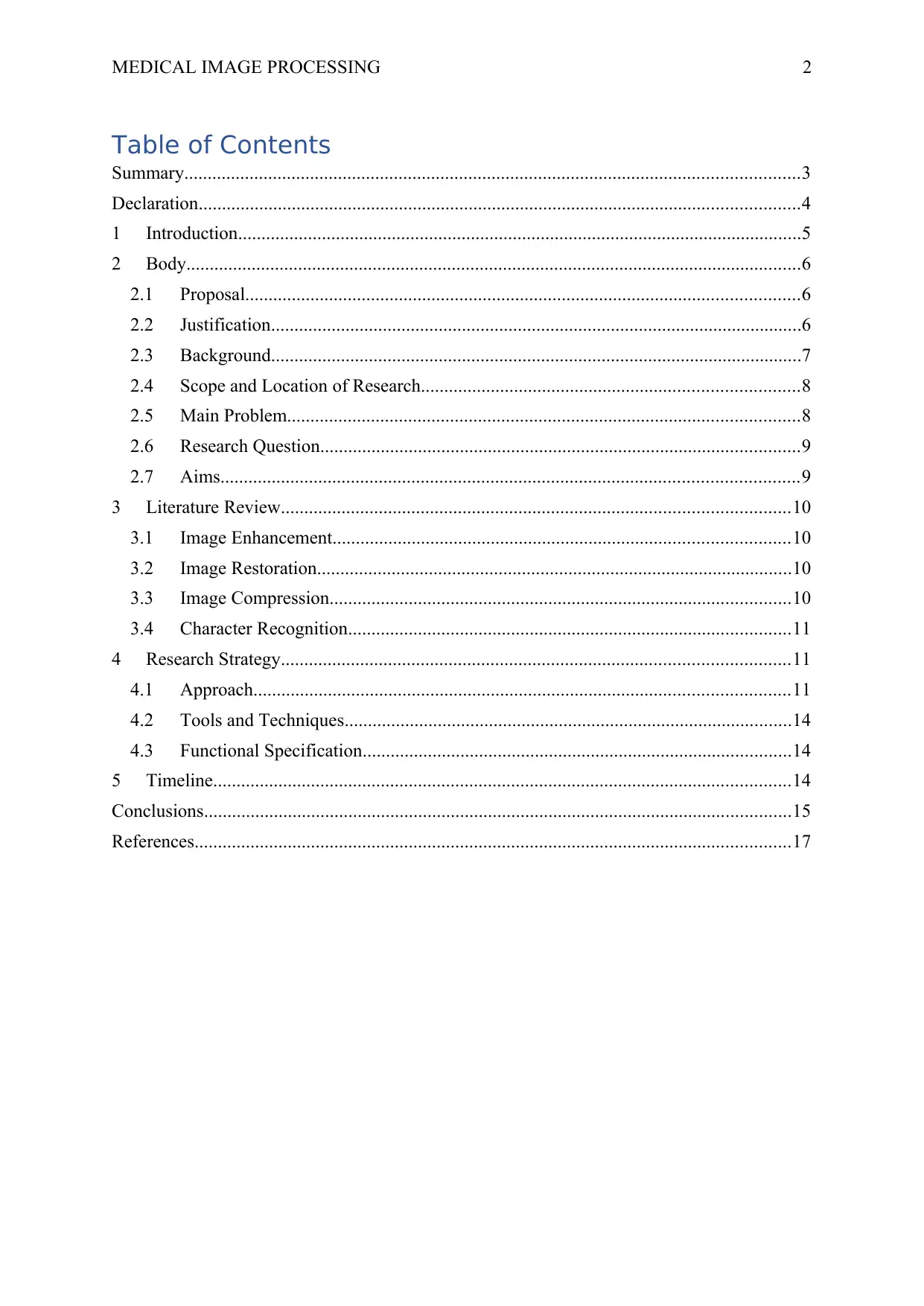
MEDICAL IMAGE PROCESSING 2
Table of Contents
Summary....................................................................................................................................3
Declaration.................................................................................................................................4
1 Introduction.........................................................................................................................5
2 Body....................................................................................................................................6
2.1 Proposal.......................................................................................................................6
2.2 Justification..................................................................................................................6
2.3 Background..................................................................................................................7
2.4 Scope and Location of Research.................................................................................8
2.5 Main Problem..............................................................................................................8
2.6 Research Question.......................................................................................................9
2.7 Aims............................................................................................................................9
3 Literature Review.............................................................................................................10
3.1 Image Enhancement..................................................................................................10
3.2 Image Restoration......................................................................................................10
3.3 Image Compression...................................................................................................10
3.4 Character Recognition...............................................................................................11
4 Research Strategy.............................................................................................................11
4.1 Approach...................................................................................................................11
4.2 Tools and Techniques................................................................................................14
4.3 Functional Specification............................................................................................14
5 Timeline............................................................................................................................14
Conclusions..............................................................................................................................15
References................................................................................................................................17
Table of Contents
Summary....................................................................................................................................3
Declaration.................................................................................................................................4
1 Introduction.........................................................................................................................5
2 Body....................................................................................................................................6
2.1 Proposal.......................................................................................................................6
2.2 Justification..................................................................................................................6
2.3 Background..................................................................................................................7
2.4 Scope and Location of Research.................................................................................8
2.5 Main Problem..............................................................................................................8
2.6 Research Question.......................................................................................................9
2.7 Aims............................................................................................................................9
3 Literature Review.............................................................................................................10
3.1 Image Enhancement..................................................................................................10
3.2 Image Restoration......................................................................................................10
3.3 Image Compression...................................................................................................10
3.4 Character Recognition...............................................................................................11
4 Research Strategy.............................................................................................................11
4.1 Approach...................................................................................................................11
4.2 Tools and Techniques................................................................................................14
4.3 Functional Specification............................................................................................14
5 Timeline............................................................................................................................14
Conclusions..............................................................................................................................15
References................................................................................................................................17
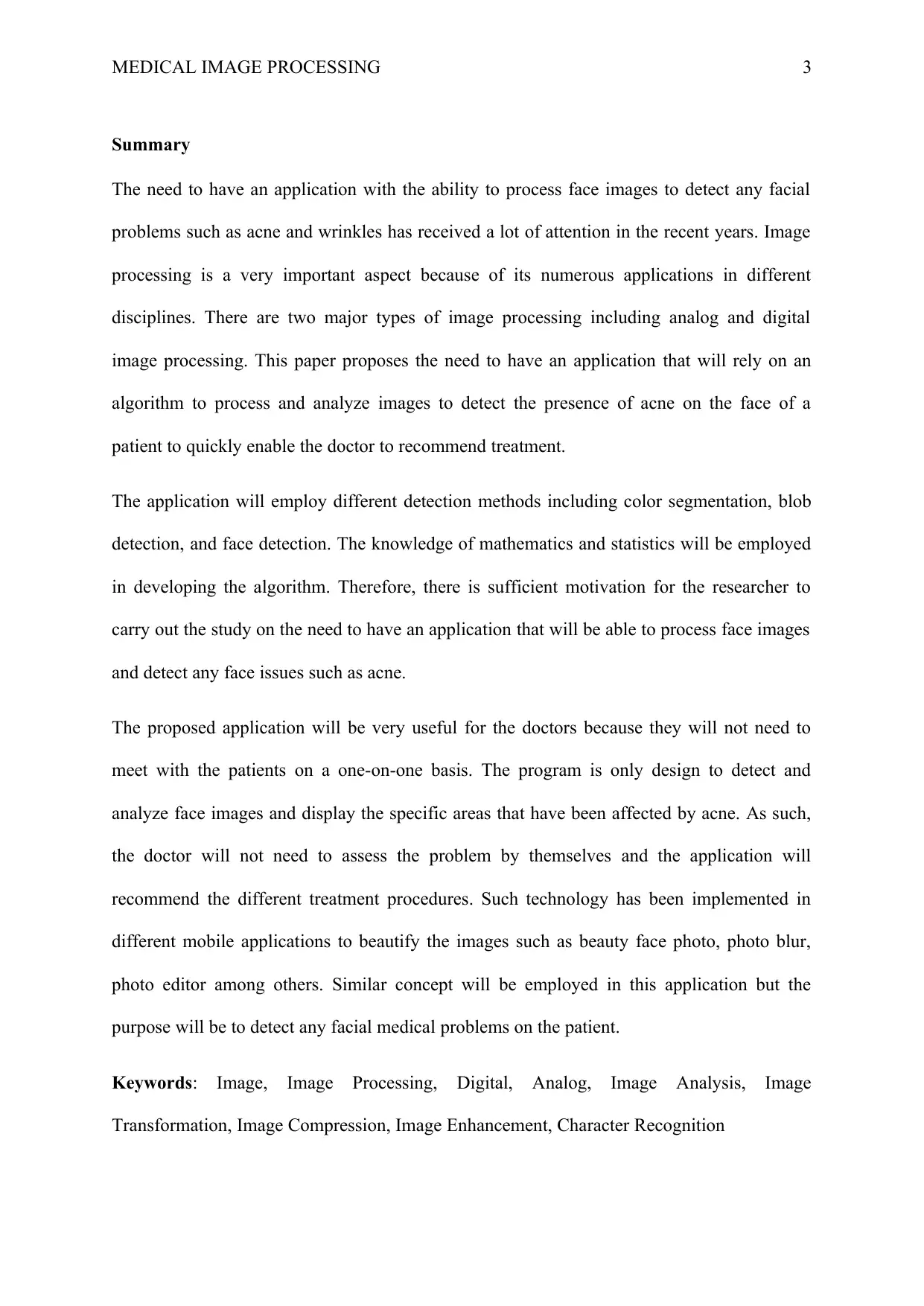
MEDICAL IMAGE PROCESSING 3
Summary
The need to have an application with the ability to process face images to detect any facial
problems such as acne and wrinkles has received a lot of attention in the recent years. Image
processing is a very important aspect because of its numerous applications in different
disciplines. There are two major types of image processing including analog and digital
image processing. This paper proposes the need to have an application that will rely on an
algorithm to process and analyze images to detect the presence of acne on the face of a
patient to quickly enable the doctor to recommend treatment.
The application will employ different detection methods including color segmentation, blob
detection, and face detection. The knowledge of mathematics and statistics will be employed
in developing the algorithm. Therefore, there is sufficient motivation for the researcher to
carry out the study on the need to have an application that will be able to process face images
and detect any face issues such as acne.
The proposed application will be very useful for the doctors because they will not need to
meet with the patients on a one-on-one basis. The program is only design to detect and
analyze face images and display the specific areas that have been affected by acne. As such,
the doctor will not need to assess the problem by themselves and the application will
recommend the different treatment procedures. Such technology has been implemented in
different mobile applications to beautify the images such as beauty face photo, photo blur,
photo editor among others. Similar concept will be employed in this application but the
purpose will be to detect any facial medical problems on the patient.
Keywords: Image, Image Processing, Digital, Analog, Image Analysis, Image
Transformation, Image Compression, Image Enhancement, Character Recognition
Summary
The need to have an application with the ability to process face images to detect any facial
problems such as acne and wrinkles has received a lot of attention in the recent years. Image
processing is a very important aspect because of its numerous applications in different
disciplines. There are two major types of image processing including analog and digital
image processing. This paper proposes the need to have an application that will rely on an
algorithm to process and analyze images to detect the presence of acne on the face of a
patient to quickly enable the doctor to recommend treatment.
The application will employ different detection methods including color segmentation, blob
detection, and face detection. The knowledge of mathematics and statistics will be employed
in developing the algorithm. Therefore, there is sufficient motivation for the researcher to
carry out the study on the need to have an application that will be able to process face images
and detect any face issues such as acne.
The proposed application will be very useful for the doctors because they will not need to
meet with the patients on a one-on-one basis. The program is only design to detect and
analyze face images and display the specific areas that have been affected by acne. As such,
the doctor will not need to assess the problem by themselves and the application will
recommend the different treatment procedures. Such technology has been implemented in
different mobile applications to beautify the images such as beauty face photo, photo blur,
photo editor among others. Similar concept will be employed in this application but the
purpose will be to detect any facial medical problems on the patient.
Keywords: Image, Image Processing, Digital, Analog, Image Analysis, Image
Transformation, Image Compression, Image Enhancement, Character Recognition
⊘ This is a preview!⊘
Do you want full access?
Subscribe today to unlock all pages.

Trusted by 1+ million students worldwide
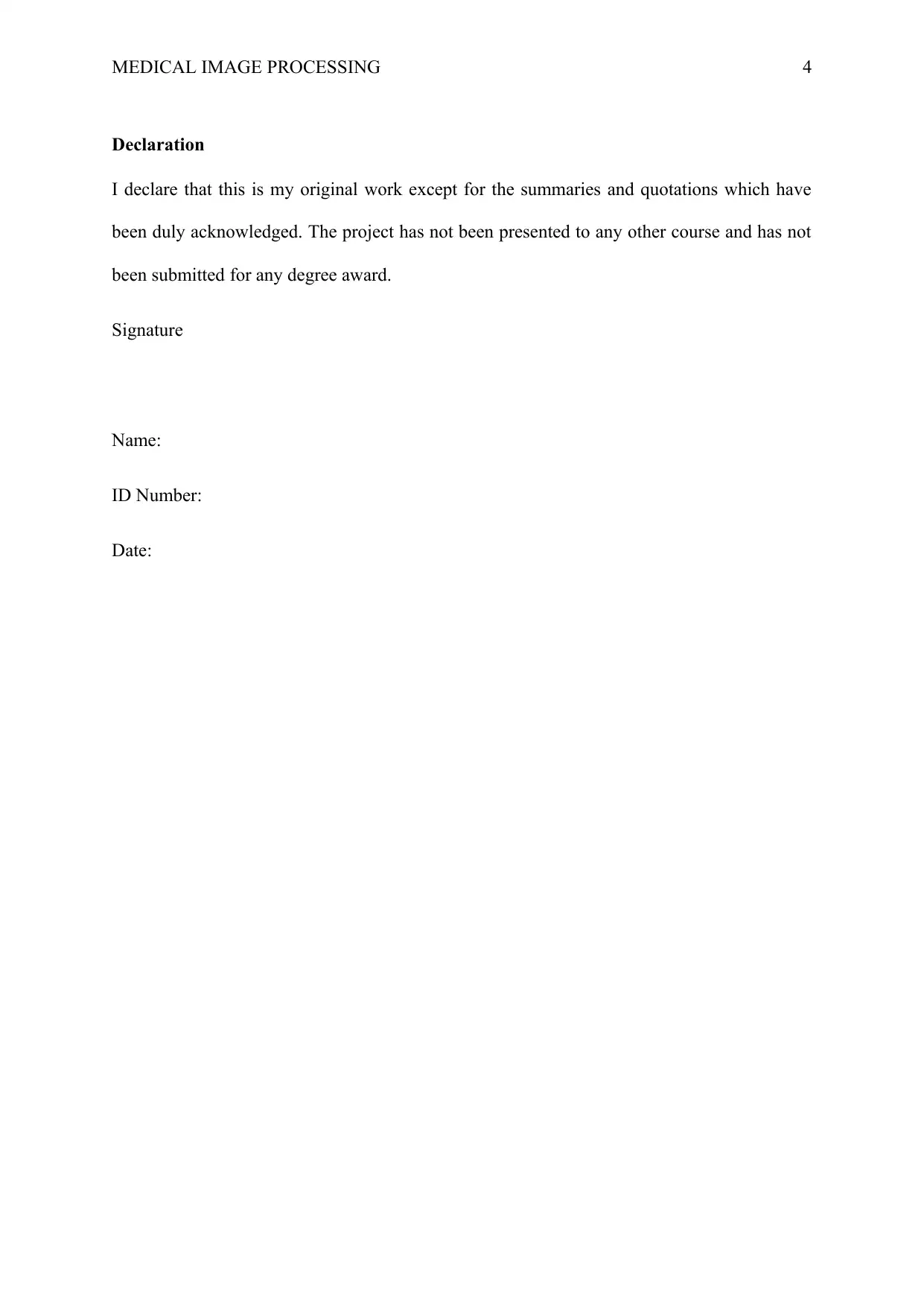
MEDICAL IMAGE PROCESSING 4
Declaration
I declare that this is my original work except for the summaries and quotations which have
been duly acknowledged. The project has not been presented to any other course and has not
been submitted for any degree award.
Signature
Name:
ID Number:
Date:
Declaration
I declare that this is my original work except for the summaries and quotations which have
been duly acknowledged. The project has not been presented to any other course and has not
been submitted for any degree award.
Signature
Name:
ID Number:
Date:
Paraphrase This Document
Need a fresh take? Get an instant paraphrase of this document with our AI Paraphraser
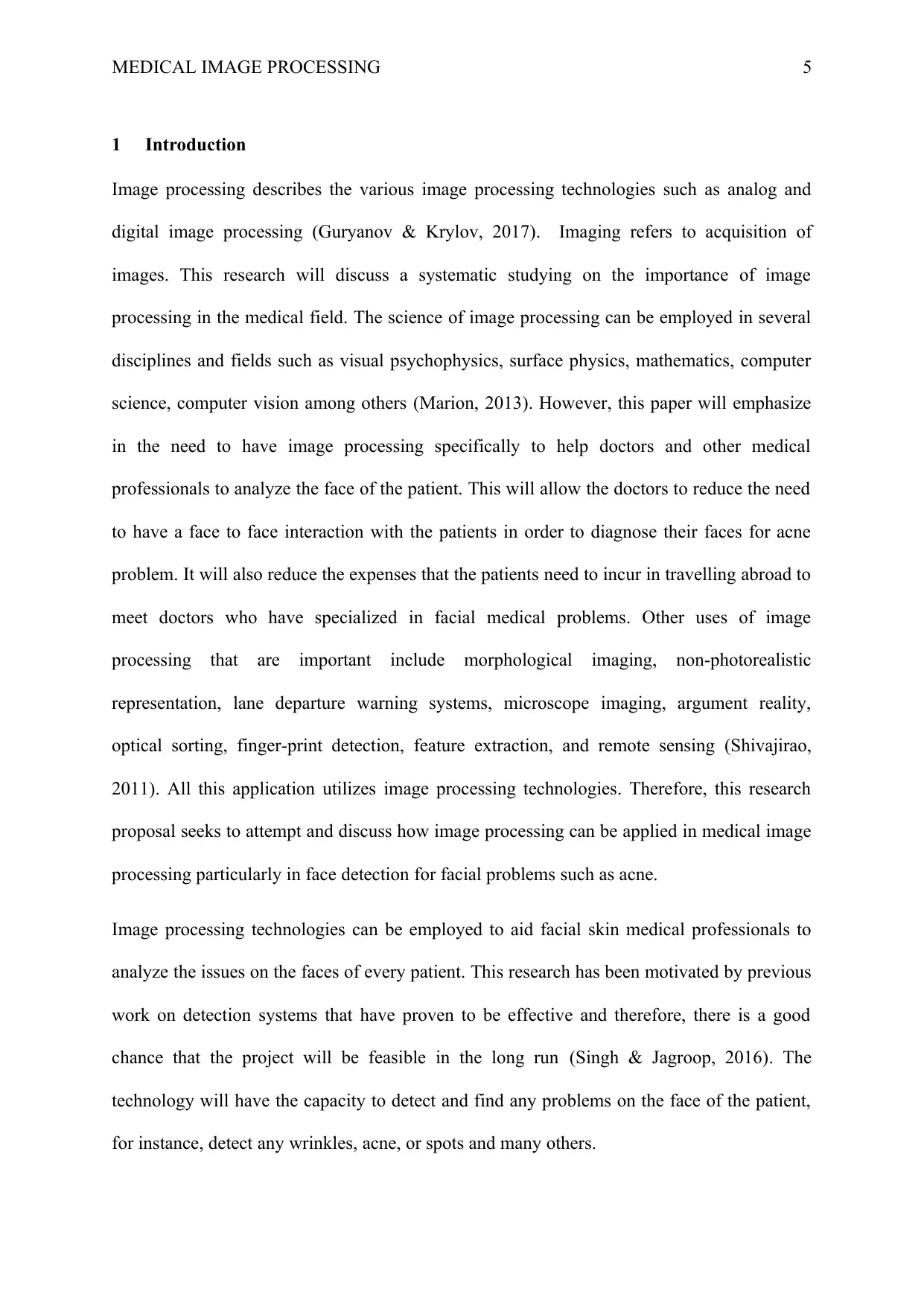
MEDICAL IMAGE PROCESSING 5
1 Introduction
Image processing describes the various image processing technologies such as analog and
digital image processing (Guryanov & Krylov, 2017). Imaging refers to acquisition of
images. This research will discuss a systematic studying on the importance of image
processing in the medical field. The science of image processing can be employed in several
disciplines and fields such as visual psychophysics, surface physics, mathematics, computer
science, computer vision among others (Marion, 2013). However, this paper will emphasize
in the need to have image processing specifically to help doctors and other medical
professionals to analyze the face of the patient. This will allow the doctors to reduce the need
to have a face to face interaction with the patients in order to diagnose their faces for acne
problem. It will also reduce the expenses that the patients need to incur in travelling abroad to
meet doctors who have specialized in facial medical problems. Other uses of image
processing that are important include morphological imaging, non-photorealistic
representation, lane departure warning systems, microscope imaging, argument reality,
optical sorting, finger-print detection, feature extraction, and remote sensing (Shivajirao,
2011). All this application utilizes image processing technologies. Therefore, this research
proposal seeks to attempt and discuss how image processing can be applied in medical image
processing particularly in face detection for facial problems such as acne.
Image processing technologies can be employed to aid facial skin medical professionals to
analyze the issues on the faces of every patient. This research has been motivated by previous
work on detection systems that have proven to be effective and therefore, there is a good
chance that the project will be feasible in the long run (Singh & Jagroop, 2016). The
technology will have the capacity to detect and find any problems on the face of the patient,
for instance, detect any wrinkles, acne, or spots and many others.
1 Introduction
Image processing describes the various image processing technologies such as analog and
digital image processing (Guryanov & Krylov, 2017). Imaging refers to acquisition of
images. This research will discuss a systematic studying on the importance of image
processing in the medical field. The science of image processing can be employed in several
disciplines and fields such as visual psychophysics, surface physics, mathematics, computer
science, computer vision among others (Marion, 2013). However, this paper will emphasize
in the need to have image processing specifically to help doctors and other medical
professionals to analyze the face of the patient. This will allow the doctors to reduce the need
to have a face to face interaction with the patients in order to diagnose their faces for acne
problem. It will also reduce the expenses that the patients need to incur in travelling abroad to
meet doctors who have specialized in facial medical problems. Other uses of image
processing that are important include morphological imaging, non-photorealistic
representation, lane departure warning systems, microscope imaging, argument reality,
optical sorting, finger-print detection, feature extraction, and remote sensing (Shivajirao,
2011). All this application utilizes image processing technologies. Therefore, this research
proposal seeks to attempt and discuss how image processing can be applied in medical image
processing particularly in face detection for facial problems such as acne.
Image processing technologies can be employed to aid facial skin medical professionals to
analyze the issues on the faces of every patient. This research has been motivated by previous
work on detection systems that have proven to be effective and therefore, there is a good
chance that the project will be feasible in the long run (Singh & Jagroop, 2016). The
technology will have the capacity to detect and find any problems on the face of the patient,
for instance, detect any wrinkles, acne, or spots and many others.
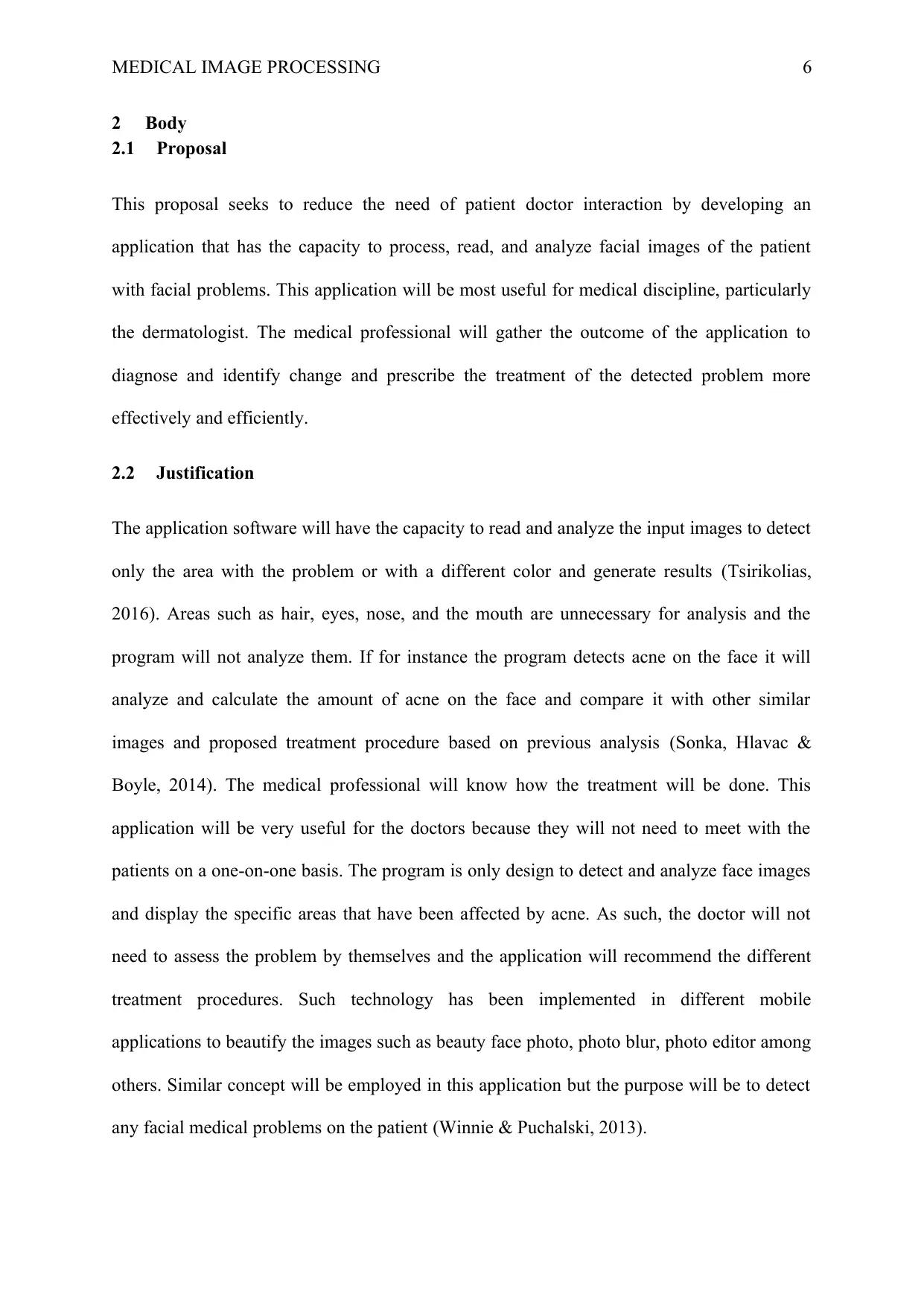
MEDICAL IMAGE PROCESSING 6
2 Body
2.1 Proposal
This proposal seeks to reduce the need of patient doctor interaction by developing an
application that has the capacity to process, read, and analyze facial images of the patient
with facial problems. This application will be most useful for medical discipline, particularly
the dermatologist. The medical professional will gather the outcome of the application to
diagnose and identify change and prescribe the treatment of the detected problem more
effectively and efficiently.
2.2 Justification
The application software will have the capacity to read and analyze the input images to detect
only the area with the problem or with a different color and generate results (Tsirikolias,
2016). Areas such as hair, eyes, nose, and the mouth are unnecessary for analysis and the
program will not analyze them. If for instance the program detects acne on the face it will
analyze and calculate the amount of acne on the face and compare it with other similar
images and proposed treatment procedure based on previous analysis (Sonka, Hlavac &
Boyle, 2014). The medical professional will know how the treatment will be done. This
application will be very useful for the doctors because they will not need to meet with the
patients on a one-on-one basis. The program is only design to detect and analyze face images
and display the specific areas that have been affected by acne. As such, the doctor will not
need to assess the problem by themselves and the application will recommend the different
treatment procedures. Such technology has been implemented in different mobile
applications to beautify the images such as beauty face photo, photo blur, photo editor among
others. Similar concept will be employed in this application but the purpose will be to detect
any facial medical problems on the patient (Winnie & Puchalski, 2013).
2 Body
2.1 Proposal
This proposal seeks to reduce the need of patient doctor interaction by developing an
application that has the capacity to process, read, and analyze facial images of the patient
with facial problems. This application will be most useful for medical discipline, particularly
the dermatologist. The medical professional will gather the outcome of the application to
diagnose and identify change and prescribe the treatment of the detected problem more
effectively and efficiently.
2.2 Justification
The application software will have the capacity to read and analyze the input images to detect
only the area with the problem or with a different color and generate results (Tsirikolias,
2016). Areas such as hair, eyes, nose, and the mouth are unnecessary for analysis and the
program will not analyze them. If for instance the program detects acne on the face it will
analyze and calculate the amount of acne on the face and compare it with other similar
images and proposed treatment procedure based on previous analysis (Sonka, Hlavac &
Boyle, 2014). The medical professional will know how the treatment will be done. This
application will be very useful for the doctors because they will not need to meet with the
patients on a one-on-one basis. The program is only design to detect and analyze face images
and display the specific areas that have been affected by acne. As such, the doctor will not
need to assess the problem by themselves and the application will recommend the different
treatment procedures. Such technology has been implemented in different mobile
applications to beautify the images such as beauty face photo, photo blur, photo editor among
others. Similar concept will be employed in this application but the purpose will be to detect
any facial medical problems on the patient (Winnie & Puchalski, 2013).
⊘ This is a preview!⊘
Do you want full access?
Subscribe today to unlock all pages.

Trusted by 1+ million students worldwide
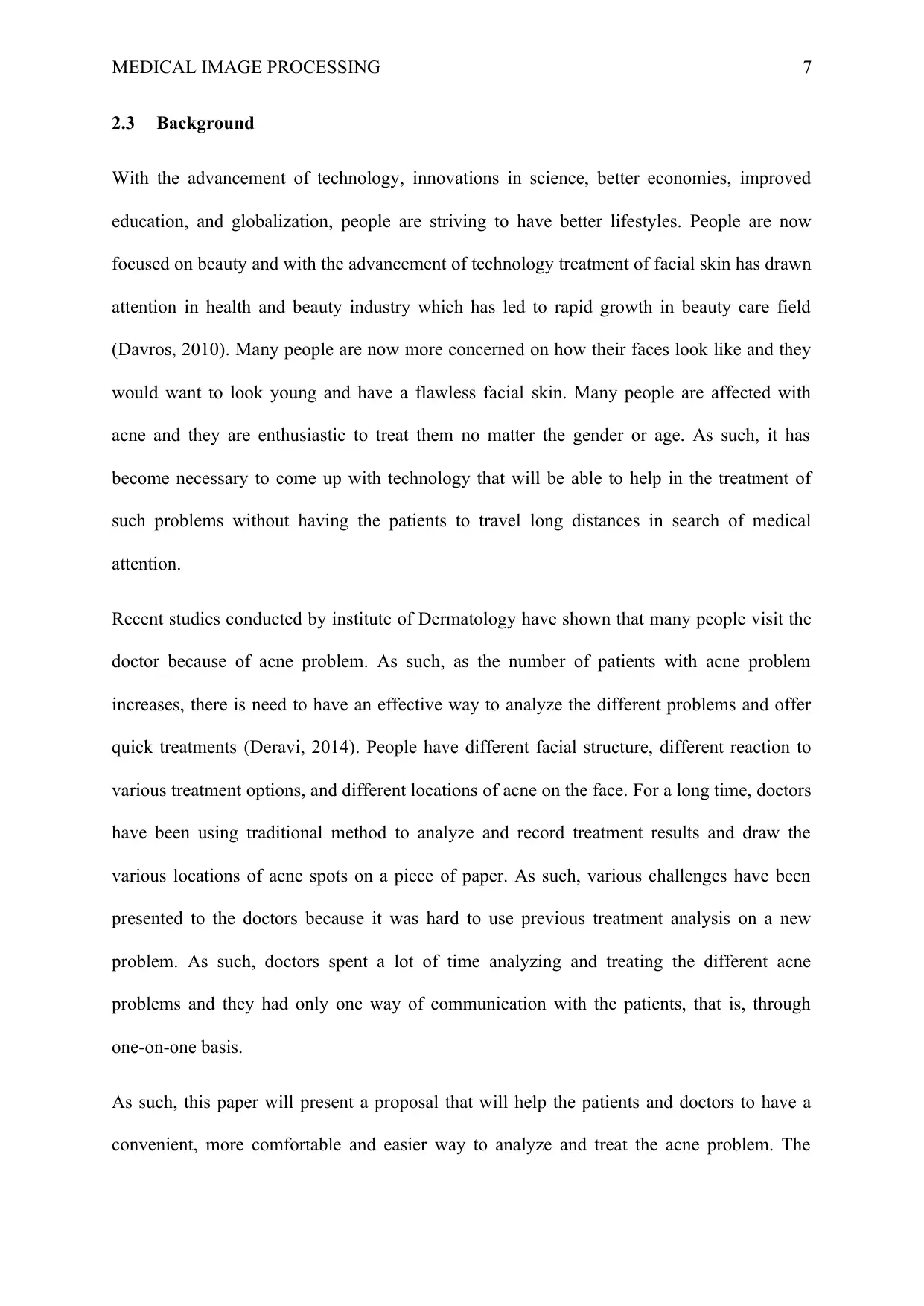
MEDICAL IMAGE PROCESSING 7
2.3 Background
With the advancement of technology, innovations in science, better economies, improved
education, and globalization, people are striving to have better lifestyles. People are now
focused on beauty and with the advancement of technology treatment of facial skin has drawn
attention in health and beauty industry which has led to rapid growth in beauty care field
(Davros, 2010). Many people are now more concerned on how their faces look like and they
would want to look young and have a flawless facial skin. Many people are affected with
acne and they are enthusiastic to treat them no matter the gender or age. As such, it has
become necessary to come up with technology that will be able to help in the treatment of
such problems without having the patients to travel long distances in search of medical
attention.
Recent studies conducted by institute of Dermatology have shown that many people visit the
doctor because of acne problem. As such, as the number of patients with acne problem
increases, there is need to have an effective way to analyze the different problems and offer
quick treatments (Deravi, 2014). People have different facial structure, different reaction to
various treatment options, and different locations of acne on the face. For a long time, doctors
have been using traditional method to analyze and record treatment results and draw the
various locations of acne spots on a piece of paper. As such, various challenges have been
presented to the doctors because it was hard to use previous treatment analysis on a new
problem. As such, doctors spent a lot of time analyzing and treating the different acne
problems and they had only one way of communication with the patients, that is, through
one-on-one basis.
As such, this paper will present a proposal that will help the patients and doctors to have a
convenient, more comfortable and easier way to analyze and treat the acne problem. The
2.3 Background
With the advancement of technology, innovations in science, better economies, improved
education, and globalization, people are striving to have better lifestyles. People are now
focused on beauty and with the advancement of technology treatment of facial skin has drawn
attention in health and beauty industry which has led to rapid growth in beauty care field
(Davros, 2010). Many people are now more concerned on how their faces look like and they
would want to look young and have a flawless facial skin. Many people are affected with
acne and they are enthusiastic to treat them no matter the gender or age. As such, it has
become necessary to come up with technology that will be able to help in the treatment of
such problems without having the patients to travel long distances in search of medical
attention.
Recent studies conducted by institute of Dermatology have shown that many people visit the
doctor because of acne problem. As such, as the number of patients with acne problem
increases, there is need to have an effective way to analyze the different problems and offer
quick treatments (Deravi, 2014). People have different facial structure, different reaction to
various treatment options, and different locations of acne on the face. For a long time, doctors
have been using traditional method to analyze and record treatment results and draw the
various locations of acne spots on a piece of paper. As such, various challenges have been
presented to the doctors because it was hard to use previous treatment analysis on a new
problem. As such, doctors spent a lot of time analyzing and treating the different acne
problems and they had only one way of communication with the patients, that is, through
one-on-one basis.
As such, this paper will present a proposal that will help the patients and doctors to have a
convenient, more comfortable and easier way to analyze and treat the acne problem. The
Paraphrase This Document
Need a fresh take? Get an instant paraphrase of this document with our AI Paraphraser
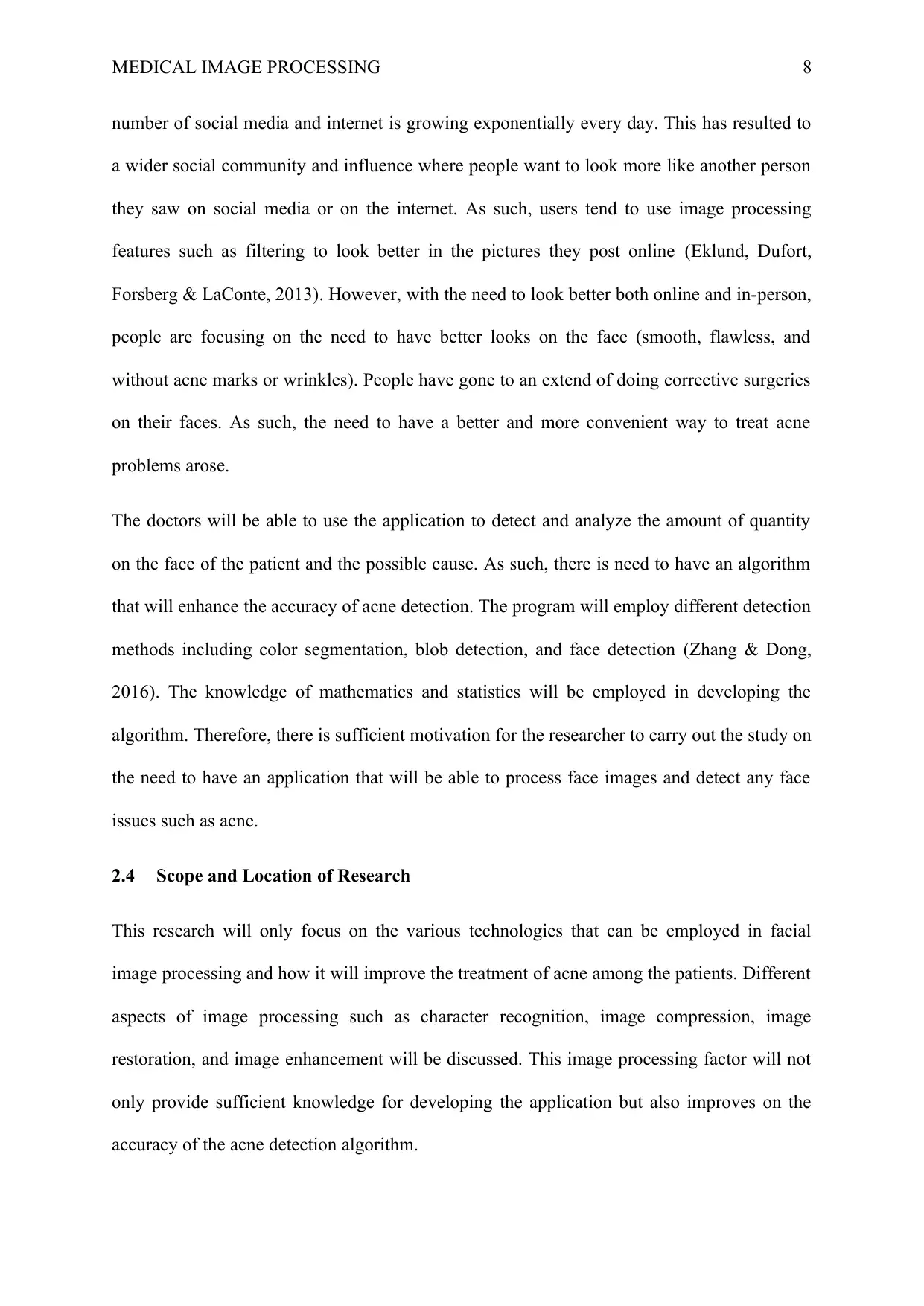
MEDICAL IMAGE PROCESSING 8
number of social media and internet is growing exponentially every day. This has resulted to
a wider social community and influence where people want to look more like another person
they saw on social media or on the internet. As such, users tend to use image processing
features such as filtering to look better in the pictures they post online (Eklund, Dufort,
Forsberg & LaConte, 2013). However, with the need to look better both online and in-person,
people are focusing on the need to have better looks on the face (smooth, flawless, and
without acne marks or wrinkles). People have gone to an extend of doing corrective surgeries
on their faces. As such, the need to have a better and more convenient way to treat acne
problems arose.
The doctors will be able to use the application to detect and analyze the amount of quantity
on the face of the patient and the possible cause. As such, there is need to have an algorithm
that will enhance the accuracy of acne detection. The program will employ different detection
methods including color segmentation, blob detection, and face detection (Zhang & Dong,
2016). The knowledge of mathematics and statistics will be employed in developing the
algorithm. Therefore, there is sufficient motivation for the researcher to carry out the study on
the need to have an application that will be able to process face images and detect any face
issues such as acne.
2.4 Scope and Location of Research
This research will only focus on the various technologies that can be employed in facial
image processing and how it will improve the treatment of acne among the patients. Different
aspects of image processing such as character recognition, image compression, image
restoration, and image enhancement will be discussed. This image processing factor will not
only provide sufficient knowledge for developing the application but also improves on the
accuracy of the acne detection algorithm.
number of social media and internet is growing exponentially every day. This has resulted to
a wider social community and influence where people want to look more like another person
they saw on social media or on the internet. As such, users tend to use image processing
features such as filtering to look better in the pictures they post online (Eklund, Dufort,
Forsberg & LaConte, 2013). However, with the need to look better both online and in-person,
people are focusing on the need to have better looks on the face (smooth, flawless, and
without acne marks or wrinkles). People have gone to an extend of doing corrective surgeries
on their faces. As such, the need to have a better and more convenient way to treat acne
problems arose.
The doctors will be able to use the application to detect and analyze the amount of quantity
on the face of the patient and the possible cause. As such, there is need to have an algorithm
that will enhance the accuracy of acne detection. The program will employ different detection
methods including color segmentation, blob detection, and face detection (Zhang & Dong,
2016). The knowledge of mathematics and statistics will be employed in developing the
algorithm. Therefore, there is sufficient motivation for the researcher to carry out the study on
the need to have an application that will be able to process face images and detect any face
issues such as acne.
2.4 Scope and Location of Research
This research will only focus on the various technologies that can be employed in facial
image processing and how it will improve the treatment of acne among the patients. Different
aspects of image processing such as character recognition, image compression, image
restoration, and image enhancement will be discussed. This image processing factor will not
only provide sufficient knowledge for developing the application but also improves on the
accuracy of the acne detection algorithm.
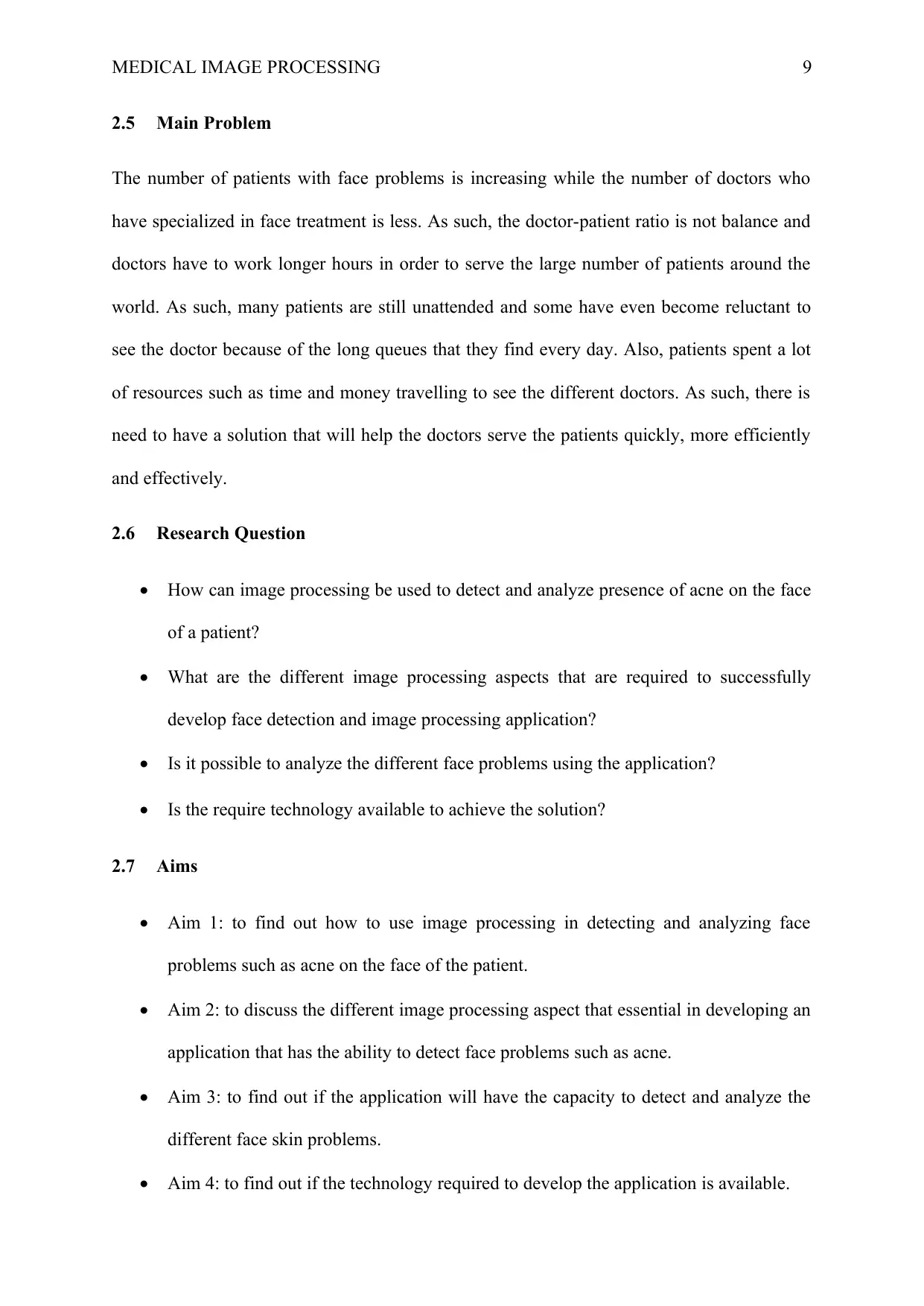
MEDICAL IMAGE PROCESSING 9
2.5 Main Problem
The number of patients with face problems is increasing while the number of doctors who
have specialized in face treatment is less. As such, the doctor-patient ratio is not balance and
doctors have to work longer hours in order to serve the large number of patients around the
world. As such, many patients are still unattended and some have even become reluctant to
see the doctor because of the long queues that they find every day. Also, patients spent a lot
of resources such as time and money travelling to see the different doctors. As such, there is
need to have a solution that will help the doctors serve the patients quickly, more efficiently
and effectively.
2.6 Research Question
How can image processing be used to detect and analyze presence of acne on the face
of a patient?
What are the different image processing aspects that are required to successfully
develop face detection and image processing application?
Is it possible to analyze the different face problems using the application?
Is the require technology available to achieve the solution?
2.7 Aims
Aim 1: to find out how to use image processing in detecting and analyzing face
problems such as acne on the face of the patient.
Aim 2: to discuss the different image processing aspect that essential in developing an
application that has the ability to detect face problems such as acne.
Aim 3: to find out if the application will have the capacity to detect and analyze the
different face skin problems.
Aim 4: to find out if the technology required to develop the application is available.
2.5 Main Problem
The number of patients with face problems is increasing while the number of doctors who
have specialized in face treatment is less. As such, the doctor-patient ratio is not balance and
doctors have to work longer hours in order to serve the large number of patients around the
world. As such, many patients are still unattended and some have even become reluctant to
see the doctor because of the long queues that they find every day. Also, patients spent a lot
of resources such as time and money travelling to see the different doctors. As such, there is
need to have a solution that will help the doctors serve the patients quickly, more efficiently
and effectively.
2.6 Research Question
How can image processing be used to detect and analyze presence of acne on the face
of a patient?
What are the different image processing aspects that are required to successfully
develop face detection and image processing application?
Is it possible to analyze the different face problems using the application?
Is the require technology available to achieve the solution?
2.7 Aims
Aim 1: to find out how to use image processing in detecting and analyzing face
problems such as acne on the face of the patient.
Aim 2: to discuss the different image processing aspect that essential in developing an
application that has the ability to detect face problems such as acne.
Aim 3: to find out if the application will have the capacity to detect and analyze the
different face skin problems.
Aim 4: to find out if the technology required to develop the application is available.
⊘ This is a preview!⊘
Do you want full access?
Subscribe today to unlock all pages.

Trusted by 1+ million students worldwide
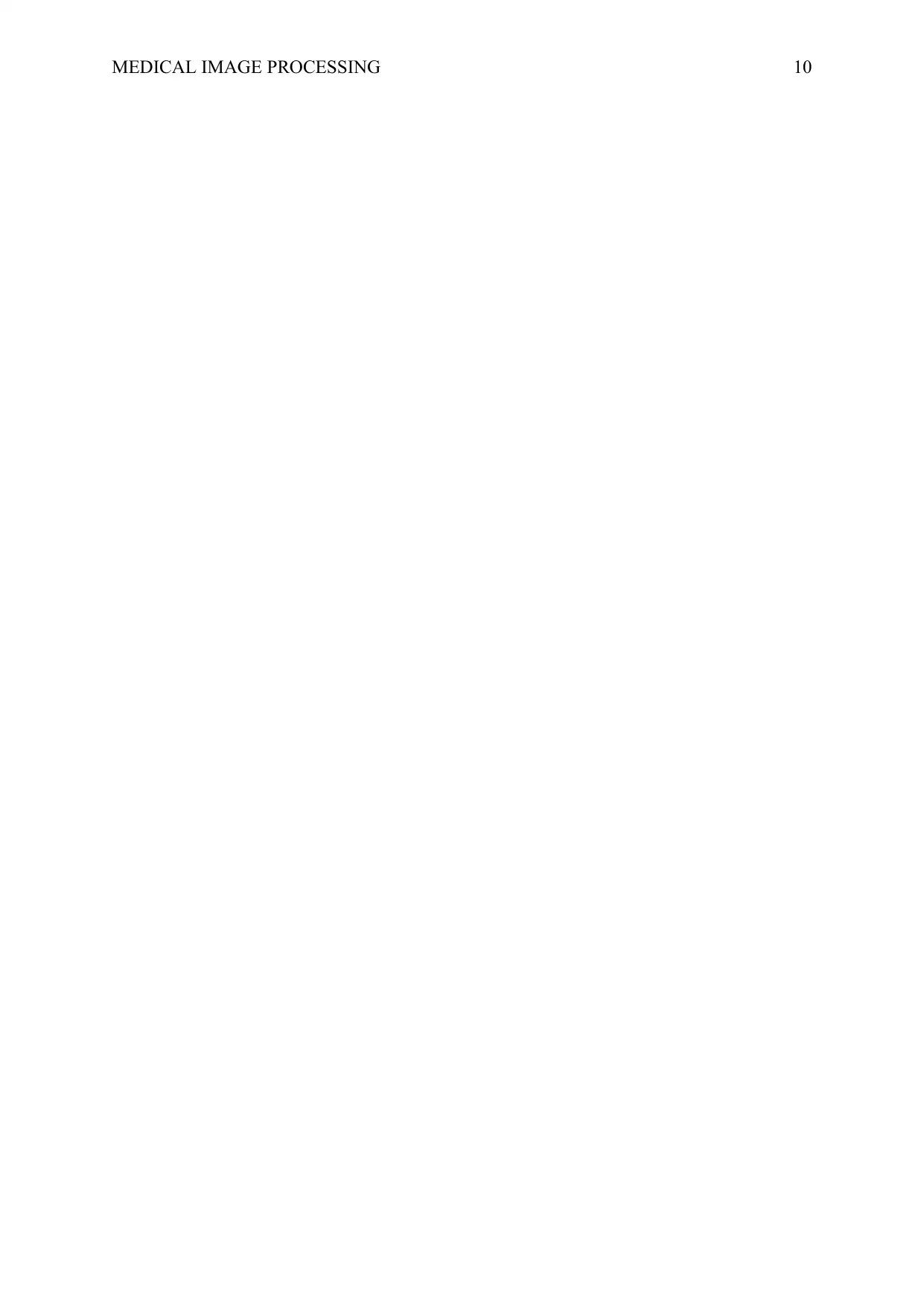
MEDICAL IMAGE PROCESSING 10
Paraphrase This Document
Need a fresh take? Get an instant paraphrase of this document with our AI Paraphraser
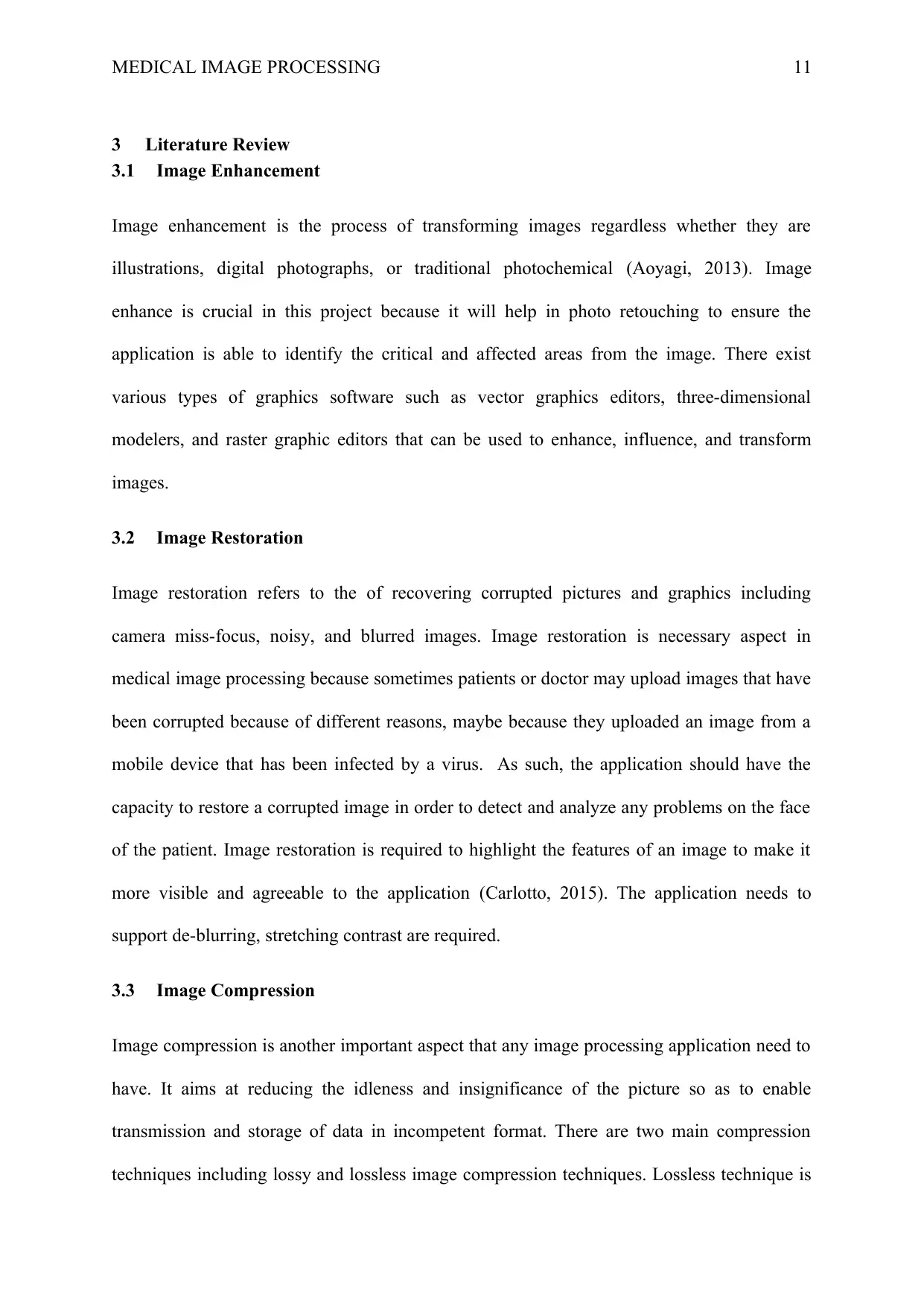
MEDICAL IMAGE PROCESSING 11
3 Literature Review
3.1 Image Enhancement
Image enhancement is the process of transforming images regardless whether they are
illustrations, digital photographs, or traditional photochemical (Aoyagi, 2013). Image
enhance is crucial in this project because it will help in photo retouching to ensure the
application is able to identify the critical and affected areas from the image. There exist
various types of graphics software such as vector graphics editors, three-dimensional
modelers, and raster graphic editors that can be used to enhance, influence, and transform
images.
3.2 Image Restoration
Image restoration refers to the of recovering corrupted pictures and graphics including
camera miss-focus, noisy, and blurred images. Image restoration is necessary aspect in
medical image processing because sometimes patients or doctor may upload images that have
been corrupted because of different reasons, maybe because they uploaded an image from a
mobile device that has been infected by a virus. As such, the application should have the
capacity to restore a corrupted image in order to detect and analyze any problems on the face
of the patient. Image restoration is required to highlight the features of an image to make it
more visible and agreeable to the application (Carlotto, 2015). The application needs to
support de-blurring, stretching contrast are required.
3.3 Image Compression
Image compression is another important aspect that any image processing application need to
have. It aims at reducing the idleness and insignificance of the picture so as to enable
transmission and storage of data in incompetent format. There are two main compression
techniques including lossy and lossless image compression techniques. Lossless technique is
3 Literature Review
3.1 Image Enhancement
Image enhancement is the process of transforming images regardless whether they are
illustrations, digital photographs, or traditional photochemical (Aoyagi, 2013). Image
enhance is crucial in this project because it will help in photo retouching to ensure the
application is able to identify the critical and affected areas from the image. There exist
various types of graphics software such as vector graphics editors, three-dimensional
modelers, and raster graphic editors that can be used to enhance, influence, and transform
images.
3.2 Image Restoration
Image restoration refers to the of recovering corrupted pictures and graphics including
camera miss-focus, noisy, and blurred images. Image restoration is necessary aspect in
medical image processing because sometimes patients or doctor may upload images that have
been corrupted because of different reasons, maybe because they uploaded an image from a
mobile device that has been infected by a virus. As such, the application should have the
capacity to restore a corrupted image in order to detect and analyze any problems on the face
of the patient. Image restoration is required to highlight the features of an image to make it
more visible and agreeable to the application (Carlotto, 2015). The application needs to
support de-blurring, stretching contrast are required.
3.3 Image Compression
Image compression is another important aspect that any image processing application need to
have. It aims at reducing the idleness and insignificance of the picture so as to enable
transmission and storage of data in incompetent format. There are two main compression
techniques including lossy and lossless image compression techniques. Lossless technique is
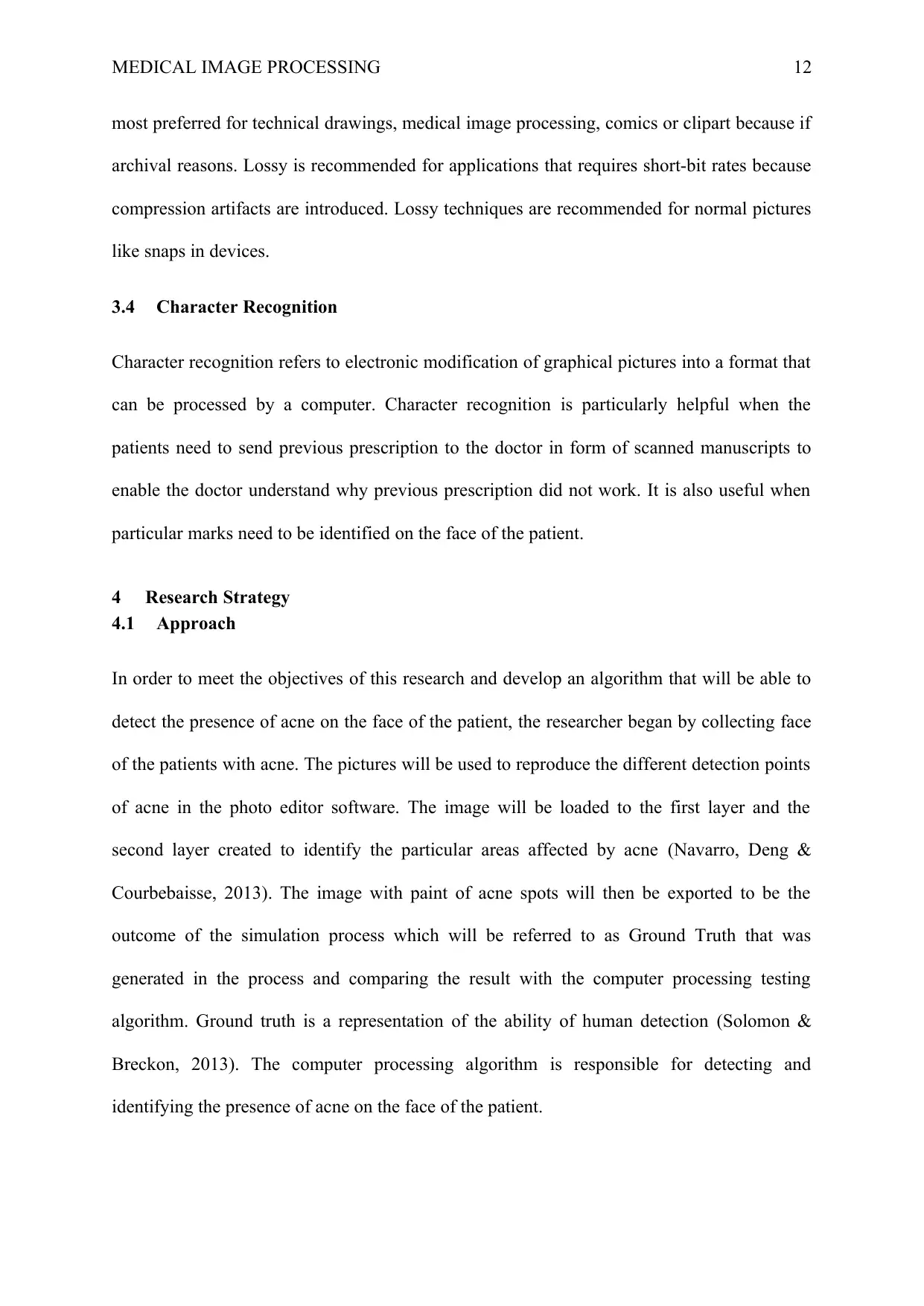
MEDICAL IMAGE PROCESSING 12
most preferred for technical drawings, medical image processing, comics or clipart because if
archival reasons. Lossy is recommended for applications that requires short-bit rates because
compression artifacts are introduced. Lossy techniques are recommended for normal pictures
like snaps in devices.
3.4 Character Recognition
Character recognition refers to electronic modification of graphical pictures into a format that
can be processed by a computer. Character recognition is particularly helpful when the
patients need to send previous prescription to the doctor in form of scanned manuscripts to
enable the doctor understand why previous prescription did not work. It is also useful when
particular marks need to be identified on the face of the patient.
4 Research Strategy
4.1 Approach
In order to meet the objectives of this research and develop an algorithm that will be able to
detect the presence of acne on the face of the patient, the researcher began by collecting face
of the patients with acne. The pictures will be used to reproduce the different detection points
of acne in the photo editor software. The image will be loaded to the first layer and the
second layer created to identify the particular areas affected by acne (Navarro, Deng &
Courbebaisse, 2013). The image with paint of acne spots will then be exported to be the
outcome of the simulation process which will be referred to as Ground Truth that was
generated in the process and comparing the result with the computer processing testing
algorithm. Ground truth is a representation of the ability of human detection (Solomon &
Breckon, 2013). The computer processing algorithm is responsible for detecting and
identifying the presence of acne on the face of the patient.
most preferred for technical drawings, medical image processing, comics or clipart because if
archival reasons. Lossy is recommended for applications that requires short-bit rates because
compression artifacts are introduced. Lossy techniques are recommended for normal pictures
like snaps in devices.
3.4 Character Recognition
Character recognition refers to electronic modification of graphical pictures into a format that
can be processed by a computer. Character recognition is particularly helpful when the
patients need to send previous prescription to the doctor in form of scanned manuscripts to
enable the doctor understand why previous prescription did not work. It is also useful when
particular marks need to be identified on the face of the patient.
4 Research Strategy
4.1 Approach
In order to meet the objectives of this research and develop an algorithm that will be able to
detect the presence of acne on the face of the patient, the researcher began by collecting face
of the patients with acne. The pictures will be used to reproduce the different detection points
of acne in the photo editor software. The image will be loaded to the first layer and the
second layer created to identify the particular areas affected by acne (Navarro, Deng &
Courbebaisse, 2013). The image with paint of acne spots will then be exported to be the
outcome of the simulation process which will be referred to as Ground Truth that was
generated in the process and comparing the result with the computer processing testing
algorithm. Ground truth is a representation of the ability of human detection (Solomon &
Breckon, 2013). The computer processing algorithm is responsible for detecting and
identifying the presence of acne on the face of the patient.
⊘ This is a preview!⊘
Do you want full access?
Subscribe today to unlock all pages.

Trusted by 1+ million students worldwide
1 out of 20
Related Documents
Your All-in-One AI-Powered Toolkit for Academic Success.
+13062052269
info@desklib.com
Available 24*7 on WhatsApp / Email
![[object Object]](/_next/static/media/star-bottom.7253800d.svg)
Unlock your academic potential
Copyright © 2020–2025 A2Z Services. All Rights Reserved. Developed and managed by ZUCOL.





